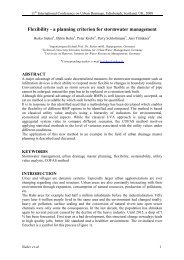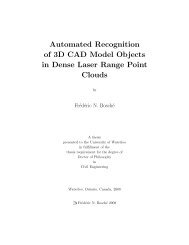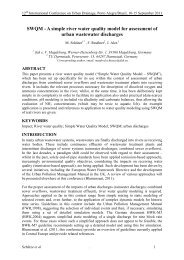ACME 2011 Proceedings of the 19 UK National Conference of the ...
ACME 2011 Proceedings of the 19 UK National Conference of the ...
ACME 2011 Proceedings of the 19 UK National Conference of the ...
You also want an ePaper? Increase the reach of your titles
YUMPU automatically turns print PDFs into web optimized ePapers that Google loves.
4 CONCLUSIONS<br />
The following conclusions were derived from <strong>the</strong> current work:<br />
• Inverse parameter optimization seems to be a feasible technique for material-parameter<br />
estimation <strong>of</strong> human arteries.<br />
• Non-invasive procedures can be employed for determining <strong>the</strong> arterial material properties.<br />
• A high degree <strong>of</strong> agreement was observed between <strong>the</strong> experimental and model predicted<br />
values obtained from <strong>the</strong> Levenberg-Marquardt optimization routine and <strong>the</strong> error in<br />
most cases was found to be less than 1%.<br />
• This study provides <strong>the</strong> motivation to implement non-invasive and patient-specific arterial<br />
material property estimation in multi-dimensions (up to 4D).<br />
Currently, most CFD studies on blood flow simulations rely on an assumed value <strong>of</strong> elasticity<br />
for <strong>the</strong> arterial walls. Hence, <strong>the</strong> primary accomplishment <strong>of</strong> this work was to illustrate <strong>the</strong><br />
possibility <strong>of</strong> having a well-defined model for non-invasively extracting <strong>the</strong> properties <strong>of</strong> human<br />
arteries via inverse optimization.<br />
It is aimed to work towards <strong>the</strong> development <strong>of</strong> a new and advanced methodology that could<br />
act as a substitute to <strong>the</strong> current risk assessment and diagnostic procedures being implemented<br />
in health care. The evaluation <strong>of</strong> arterial stiffness can <strong>the</strong>refore be used as a marker to predict<br />
<strong>the</strong> onset <strong>of</strong> such disease states (CVD) at a very early stage and could assist in decreasing<br />
cardiovascular mortality and increasing life expectancy. With a broader sense, blood vessel<br />
elasticity is also important to physiology, clinical problems involving surgery, angioplasty, tissue<br />
remodelling, tissue engineering, hypertonology, nephrology, neurology, gynaecology and<br />
diabetology.<br />
5 Acknowledgement<br />
The Zienkiewicz Fellowship that made this project possible is highly regarded and acknowledged.<br />
References<br />
[1] M.O.Rourke. Arterial stiffness, systolic blood pressure, and logical treatment <strong>of</strong> arterial<br />
hypertension. Hypertension, 15, 339–347, <strong>19</strong>90.<br />
[2] J.J. Oliver and D.J. Webb. Noninvasive assessment <strong>of</strong> arterial stiffness and risk <strong>of</strong><br />
a<strong>the</strong>rosclerotic events. Arteriosclerosis, Thrombosis, and Vascular Biology: Journal <strong>of</strong> <strong>the</strong><br />
Americal Heart Association, 23, 554–556, 2003.<br />
[3] J.P. Mynard and P. Nithiarasu. A 1D arterial blood flow model incorporating ventricular<br />
pressure, aortic valve and regional coronary flow using <strong>the</strong> locally conservative galerkin<br />
(LCG) method. Communications in Numerical Methods in Engineering, 24, 367–417, 2008.<br />
[4] Sam Roweis, Levenberg-Marquardt Optimization. In http://www.LS.nyu.edu/ roweis/notes<br />
/lm.pdf, Accessed on Aug. 17, 2010<br />
[5] M.J. Moulton, L.L. Creswell, R.L. Actis, K.W. Myers, M.W. Vannier, B.A. Szab and M.K.<br />
Pasque. An inverse approach to determining myocardial material properties. Journal <strong>of</strong><br />
Biomechanics, 28(8), 935–948, <strong>19</strong>95.<br />
20













